In Governors’ 2022 State of the State addresses, a common theme has been the adoption and manufacture of electric and alternative fuel vehicles and fueling/charging infrastructure as a priority area of focus for many states and territories.
by Cara Dougherty and Glenn Grimshaw
Almost two dozen Governors have discussed electric or alternative fuel vehicles in their State of the State speeches, a fourfold increase since 2021. This considerable—and bipartisan—rise in attention to electric and alternative fuel vehicles by Governors coincides with recent developments in the private sector and the federal arena. In August 2021, the three major U.S. auto manufacturers—Ford, General Motors and Stellantis—set an aspirational target to achieve sales of 40-50% of annual U.S. volumes from electric vehicles by 2030. This came on the heels of an Executive Order signed by President Joe Biden, which set a 50% zero-emission vehicle target by 2030.
Another major development was the passage and enactment of the bipartisan Infrastructure Investment and Jobs Act (IIJA), which established several new programs to facilitate the adoption of electric and alternative fuel vehicles. This included $7.5 billion for the build-out of charging infrastructure nationwide and programs to facilitate the uptake of low and no emission school buses, transit buses, and ferries. To implement these provisions, the U.S. Departments of Transportation and Energy recently established a Joint Office of Energy and Transportation.
In addition to efforts from the Biden-Harris Administration, the U.S. electricity sector has reinforced its support for the deployment of electric vehicles and charging infrastructure. The National Electric Highway Coalition (NEHC), currently comprised of more than 50 investor-owned electric companies, one electric cooperative, and the Tennessee Valley Authority, is committed to providing a coast-to-coast fast charging network for electric vehicles along major U.S. travel corridors by the end of 2023. The Edison Electric Institute “expects the number of battery-powered EVs to grow from roughly 2 million last year to at least 20 million by the end of this decade.” The NEHC has created a sustainable path to deploy thousands of EV fast charging stations needed to support the projected number of electric vehicles that are expected to be on U.S. roads in 2030.
What Governors have said in their speeches
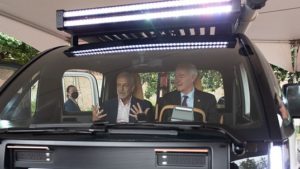
Governors focused on a range of aspects of the transition to electric and alternative fuel vehicles in their 2022 State of the State addresses. Some Governors discussed the importance of expanding electric vehicle charging networks and alternative fuel options in their states and territories. Arkansas Governor and NGA Chair Asa Hutchinson noted that to lead in electric vehicles, the state will “need to have electric charging stations across the state,” and that “this needs to be accelerated.” Connecticut Governor Ned Lamont underlined that the state budget provides for hundreds of electric charging stations as it transitions to an all-electric fleet, while Governor John Carney of Delaware emphasized the build-out of electric vehicle infrastructure as one focus of the state’s infrastructure plan. Iowa Governor Kim Reynolds supported “an all of the above approach” in the context of low emission fuels, stating that she is “introducing new legislation that will improve access to E15 and B20 [biofuels] and upgrade Iowa’s fuel infrastructure to offer higher blends.”
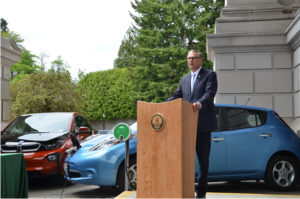
Other Governors focused on the transition of public transportation fleets to electric or alternative fuel vehicles. As part of his goal of addressing climate change, Washington Governor Jay Inslee noted that the state faces a unique opportunity with federal funds and state money “to provide nearly $1 billion to fund clean transportation programs and activities that reduce greenhouse gas emissions from the transportation sector,” which “includes $324 million to support ferry electrification.” West Virginia Governor Jim Justice highlighted a recent announcement by GreenPower Motor Company, which advised that the company has reached an “agreement with the state to manufacture zero-emission, all-electric school buses in South Charleston.” Rhode Island Governor Dan McKee underlined the state’s role as a national leader in clean energy innovation, including “the work [they’re] planning across [the] Administration to create a statewide network of electric car charging stations and converting [the state’s] public transportation vehicles to electric,” whereas Nevada Governor Steve Sisolak said that his Administration is investing in projects such as clean-energy school buses.
Several Governors underlined the role that the growing electric and clean fuel manufacturing sector will have on economic growth and jobs. Oklahoma Governor Kevin Stitt emphasized the great advantages of the location of an electric vehicle manufacturer Canoo in the state, stating that it will open a factory in the City of Pryor next year and bring 2,000 jobs to Oklahoma and at least 700 more high-paying jobs through a technology hub, software development, customer support, and financing centers. In Kentucky, Governor Andy Beshear highlighted in his State of the Commonwealth address that Ford Motor Company and SK Innovation are building the nation’s largest electric vehicle battery plants in Kentucky, which is the “largest single investment the state has ever seen.” South Carolina Governor Henry McMaster showcased investment by Oshkosh Defense, which will “invest $155 million and employ more than 1,000 Upstate residents to manufacturer the Postal Service’s new fleet of electric mail trucks.”
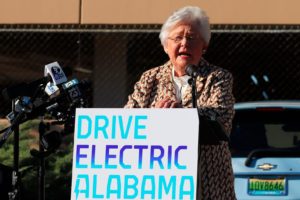
The mentions didn’t stop there. Michigan Governor Gretchen Whitmer noted a focus on increasing the uptake of electric vehicles in her State of the State address, proposing a combined $2,500 electric vehicle rebate for families comprising $2,000 for the vehicle and $500 for in-home charging equipment. Last year, Gov. Whitmer signed Executive Order 2020-2 creating the Michigan Council on Future Mobility and Electrification to enhance the state’s transition to electric vehicles and access to charging infrastructure. Despite recent strides, it is critical to acknowledge supply chain vulnerabilities in the transition to electric vehicles. Alabama Governor Kay Ivey noted that the “country will turn to Westwater Resources in Coosa County for … critical resource[s] in battery manufacturing.” Last year, Gov. Ivey and the Alabama Department of Economic and Community Affairs launched a statewide campaign, Drive Electric Alabama, to educate consumers, utility regulators, and government officials about the benefits of electric vehicles and their potential to expand green workforce in the state.
At the NGA 2022 Winter Meeting held in Washington D.C. in January, NGA’s Economic Recovery and Revitalization Task Force, led by Kentucky Gov.Beshear and South Carolina Gov. McMaster, focused on the intersection of private industry and public policy to further EV adoption, with an overview of some of the resources recently made available to states and territories. The meeting featured guest speakers Tom Stricker from Toyota, Travis Hester from General Motors, and John Bozzella from the Alliance for Automotive Innovation. Along with leveraging funding from the bipartisan IIJA, Governors are looking to partnerships with vehicle manufacturers and other private-sector stakeholders as essential to achieving broader policy objectives.
Leadership in Action
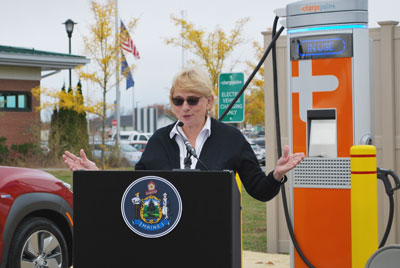
Governors are taking further measures to advance alternative fuel vehicles and networks across the nation beyond those discussed in the 2022 State of the State addresses, first through executive orders. In Maine, Governor Janet Mills signed Executive Order 36 in April 2021, which called for a “clean transportation roadmap” to expand charging infrastructure, evaluate effects on electric utilities and the grid, and ensure a fully equitable EV market in the state. In North Carolina, Governor Roy Cooper signed Executive Order 246 in January, which calls for an increase in registered zero-emission vehicles to at least 1.25 million by 2030, 50% of sales of new vehicles to be zero-emission by 2030, directs the North Carolina Department of Transportation to develop a North Carolina Clean Transportation Plan for decarbonizing the transportation sector and directs cabinet agencies to prioritize equity in the transition to a clean energy economy. In Arkansas, Gov. Hutchinson signed Executive Order 22-06 in February 2022 that establishes the Arkansas Council on Future Mobility, responsible for identifying state laws that create barriers to advanced mobility and making policy recommendations that will support the development of advanced mobility.
Governors are also taking advantage of federal funding opportunities, such as New Mexico Governor Michelle Lujan Grisham, who announced on February 11 that the state will receive $38 million over five years from the U.S. Department of Transportation to deploy EV charging infrastructure and establish an interconnected network to expand access and reliability. The federal funding will aid in building Alternative Fuel Corridors, EV charging stations on public roads, publicly accessible parking facilities and other publicly accessible locations. In October 2021, U.S. Virgin Islands Governor Albert Bryan Jr. applauded $1 million in grants awarded by the Department of Interior’s Office of Insular Affairs to the government of the Virgin Islands and the V.I. Water and Power Authority to advance the development of hybrid and electric fleet vehicles. On January 10, California Governor Gavin Newsom presented a $286.4 billion budget proposal to address climate crisis in the state, which includes $6.1 billion for electric vehicle related initiatives. California has become the first U.S. state to declare that it would ban sales of new internal combustion engines or gas-powered vehicles by 2035.
Additionally, Governors can sign legislation that codifies into law their commitments to developing clean energy transportation options, such as Florida Governor Ron DeSantis’ signing of Senate Bill 7018 in July 2020, which enacted Florida Statute 339.287 titled “Electric vehicle charging stations; infrastructure plan development.” The statute required Florida Department of Transportation to coordinate, develop, and recommend a Master Plan for the installation of electric vehicle charging station infrastructure along the State Highway System. In August 2021, New Hampshire Governor Chris Sununu signed Senate Bill 131, which encourages the use of electric vehicles, supports the manufacturing of electric vehicle supply equipment, and enables investments in electric vehicle charging infrastructure, which will altogether support the state’s tourism-based economy.
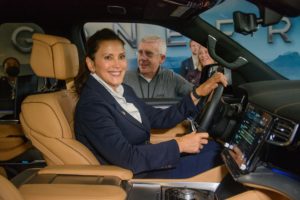
Governors are not taking on these ambitious commitments to a clean energy future alone. In September 2021, the Governors of Illinois, Indiana, Michigan, Minnesota and Wisconsin launched the Regional Electric Vehicle (REV) Midwest Coalition and have since been working together on the development of EV infrastructure. The goal of the coalition is to foster increased cooperation between participating states to advance our transportation sector’s transition to EVs and position the Midwest as a leader in EV production. Nearly one month after the network’s launch, Michigan Gov. Whitmer expressed her optimistic support and said, “Today’s REV Midwest partnership is a bipartisan effort to build the future of mobility and electrification and connect our communities… Our partnership will enable the Midwest to lead on electric vehicle adoption, reduce carbon emissions, spur innovation, and create good-paying jobs.”
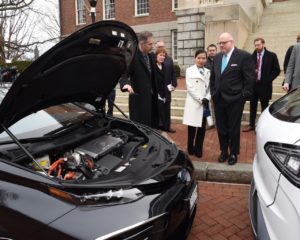
In addition to the REV Midwest Coalition, a bipartisan group of Governors representing 15 states and the District of Columbia—California, Colorado, Connecticut, Hawaii, Maine, Maryland, Massachusetts, New Jersey, New York, North Carolina, Oregon, Pennsylvania, Rhode Island, Vermont and Washington—agreed to work collaboratively to move towards zero-emission electric vehicles. They signed a memorandum of understanding in July 2020 to mark the largest-ever multi-state collaboration to clean up transportation pollution, according to the Natural Resources Defense Council. The agreed upon goal is to “ensure that 100% of all new medium- and heavy-duty vehicle sales be zero emission vehicles by 2050 with an interim target of 30% zero-emission vehicle sales by 2030.”
Low and no emissions transportation has gained significant momentum in recent years, and the 2022 State of the State addresses have reinforced Governors’ enthusiasm for intensifying this transition. Governors play a pivotal role in state efforts to transition to a clean transportation future and continue to encourage their states and territories to reduce greenhouse gas emissions by adopting more sustainable forms of transportation.












